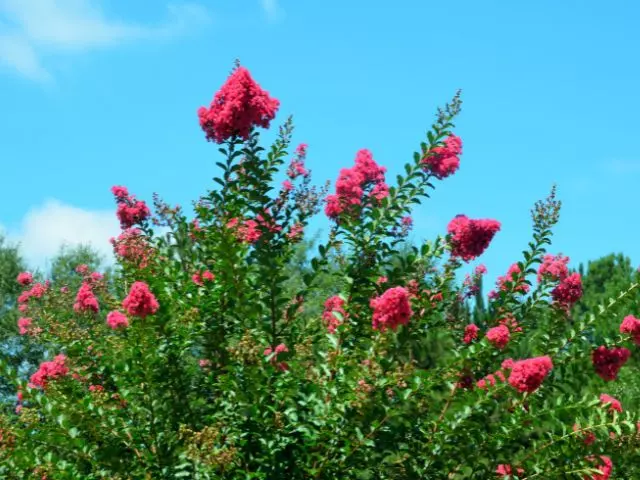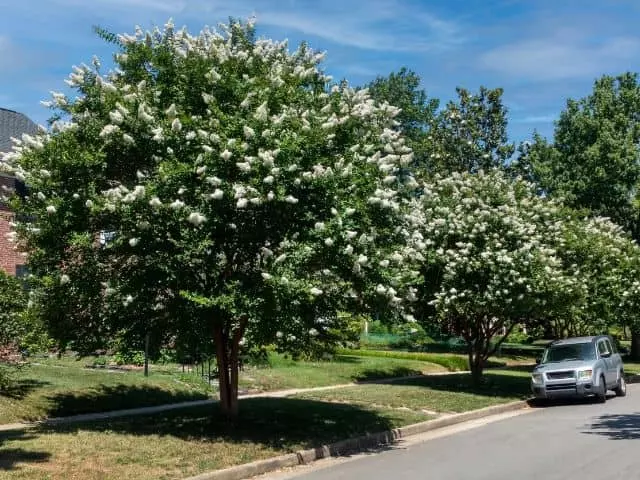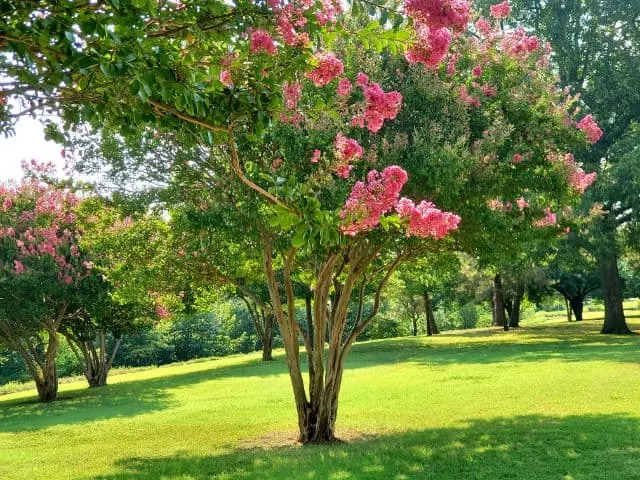If during the fall you see yellow, orange, and red leaves on your crepe myrtle, it is normal due to the fall. However, suppose you notice a sudden appearance of yellow leaves on your crepe myrtle during the spring or summer. In that case, that is a concern and requires your attention in the garden. The presence of yellowing leaves indicates a problem that the crepe myrtle is suffering from, and you will need to fix it. There are different situations where you abruptly may find crepe myrtle leaves turning yellow due to several causes. Throughout this post, I will explain how to identify the reasons behind this problem and fix the cause of yellow leaves on crepe myrtle.
Table of Contents
Why Are My Crepe Myrtle Leaves Turning Yellow
So, Why are my crepe myrtle leaves turning yellow? Yellowing leaves on a crepe myrtle shows various issues, ranging from environmental factors to pests or diseases. Here are some common reasons for crepe myrtle leaves turning yellow:
- Overwatering or underwatering causes leaves to turn yellow
- Yellowing leaves on crepe myrtle can also indicate a lack of essential nutrients
- Different pests and diseases cause yellow leaves on crepe myrtles
- Inadequate lighting conditions for growing a crepe myrtle
- Crepe myrtle leaves turning yellow due to age
All these problems that cause yellow leaves on crepe myrtles have a solution. Throughout the post, I will explain how to identify the problem to fix it correctly and keep your crepe myrtle healthy.

Newly Planted Crepe Myrtle Leaves Turning Yellow
Suppose your newly planted crepe myrtle leaves are turning yellow. In that case, focusing on the factors specific to recently transplanted trees is essential. Transplanting can be stressful for plants, and they often show signs of stress through their leaves.
Transplanting disrupts the root system, and the plant needs time to establish new roots in its new location. During this period, the crepe myrtle may exhibit symptoms such as yellowing leaves.
Be sure to water the newly planted crepe myrtle properly so that it will establish quickly. Additionally, you can add slow-release fertilizer to encourage the growth and development of the crepe myrtle.
Crepe Myrtle Leaves Turning Yellow Due to Watering Stress
Underwatering and overwatering may cause a sudden appearance of crepe myrtle leaves turning yellow. Before watering, check the soil’s moisture level around the crepe myrtle. Insert your finger about an inch into the soil. If it feels dry, it is time to water. If it is still moist, wait a day or two before checking again.
Apply a layer of organic mulch around the base of the crepe myrtle. Mulch helps retain soil moisture, regulates soil temperature, and prevents evaporation. Overwatering can suffocate the roots and lead to root rot.
Established crepe myrtle trees should be watered approximately every two weeks, provided that the upper layer of soil is dry to the touch. It would be best if you water your crepe myrtles more frequently during extremely dry and hot summers.

Crepe Myrtle Leaves Turning Yellow Due to Nutrient Deficiency
Nutrient deficiency issues can lead to your crepe myrtle leaves turning yellow. Crepe myrtles are not trees that need much fertilizer but still need nutrients and minerals to develop correctly. Most newly planted crepe myrtle trees need fertilizer.
Before fertilizing crepe myrtle, measure the soil pH. Soil pH should be between 6 and 6.5 for nutrients and minerals to be absorbed adequately by crepe myrtle. Use an 8-8-8 or 10-10-10 fertilizer. I recommend reading our article What is the best fertilizer for crepe myrtles.
- Sold on Amazon
- Crepe-Mrytle Food
- Fast Results! Feeds Through Roots and Leaves
Pests and Disease Lead to Crepe Myrtle Leaves Turning Yellow
Pests, such as aphids, spider mites, and whiteflies, among other pest-causing diseases, may cause a rapid appearance of crepe myrtle leaves turning yellow.
Aphids: These tiny insects feed on plant sap and can cause leaves to curl and turn yellow. Use a strong stream of water to wash them off the leaves, or consider using ladybugs or neem oil.
Spider Mites: These tiny arachnids can cause stippling (tiny yellow dots) on crepe myrtle leaves, which turn yellow. Keep the plants well-hydrated and use insecticidal soap to control them.
Whiteflies: Like aphids, whiteflies suck plant sap and can cause yellowing leaves on crepe myrtle. Use insecticidal soap, neem oil, or sticky traps to manage whitefly populations.
Also, diseases may cause crepe myrtle leaves to turn yellow. Powdery mildew and Cercospora leaf spot are two diseases that affect crepe myrtles and cause yellow leaves. Improve air circulation, avoid overhead watering, and consider fungicidal treatments.
Remove any infected leaves and branches promptly to prevent the spread of pests and diseases. To prune crepe myrtle correctly, I recommend reading our article on how and when to prune crepe myrtle trees.
Crepe Myrtle Leaves Turning Yellow Due to Lighting
Too low exposure to light may cause an unpredicted appearance of crepe myrtle leaves turning yellow. Crepe myrtle needs at least 6-8 hours of direct sunlight daily. Insufficient sunlight can lead to weakened growth and yellowing leaves.
On the other hand, excessive sunlight and heat can also stress the crepe myrtle and cause yellowing. That can happen if the crepe myrtle is planted in an area with intense afternoon sun or reflective heat from surfaces like concrete or buildings.
Before planting a crepe myrtle, I recommend that you carefully select the site where you will plant it to ensure it will receive the sunlight it needs to grow and develop properly.

Crepe Myrtle Yellowing Leaves Due to Aging Process
As crepe myrtle trees age, it is natural for their leaves to exhibit some changes, including a gradual appearance of yellowing. The foliage might transform into beautiful yellow tones in autumn before shedding. Crepe myrtle trees generally have a lifespan of around 25 to 50 years and consistently produce fresh leaves.
After your crepe myrtle matures to about 10 or 15 years of age, you might notice occasional instances of yellow leaves. Suppose the leaves appear to be in good condition, and there are no indications of other issues. In that case, there’s generally no need for significant concern.
Final Conclusions: Reasons Behind Yellowing Leaves in a Crepe Myrtle Tree
It would be best not to underestimate the appearance of yellow leaves on a crepe myrtle during spring and summer because it may indicate an important pathological process in the tree.
Crepe myrtle leaves may turn yellow for several reasons, including overwatering, underwatering, lack of nutrients, pests, diseases, and inadequate lighting. Identifying any of these problems that lead to your crepe myrtle leaves turning yellow is essential to fixing them as soon as possible and the key to understanding how to fix them.
On the other hand, the natural aging process may cause a gradual appearance of yellowing leaves on a healthy crepe myrtle tree. You can not fix this.
Correctly identifying the yellow leaf problem will ensure you can provide the crepe myrtle with what it needs to grow correctly. Take a comprehensive approach by examining your watering routine, soil health, light exposure, and overall maintenance.


